If the forecast calls for flooding, take precautions to prevent damage to your HVAC units.
Gaijin Panty
No Judgement Here
#BIO2018 Makes History in Boston

“We believe that because of the work that’s been done and the work that will be done moving forward, anything is possible.” – Massachusetts Governor Charlie Baker at BIO
What a history-making week in Boston! A whopping 18,289 U.S. and international attendees – the most in the last 10 years – joined us in the epicenter of the biotechnology industry for four days of inspiring programming, 46, 916 partnering meetings (setting a new Guinness World Record for “The Largest Business Partnering Event”!) and entertainment (thanks Diana Ross!).
In celebration of our 25th anniversary, we reflected on the incredible progress of the last 25 years and the innovations making history today and still to come. We were also joined throughout the week by trailblazers of our past and future, including:
- Ashanthi De Silva, the first patient in the world to receive gene therapy, who joined BIO President and CEO Jim Greenwood on stage – more than 25 years since her brave procedure – to receive the first-ever BIO History Award.
- 15 student winners of the 2018 BioGENEius Challenge – the premier competition for high school students from across the globe – who were recognized for their outstanding research and innovation in biotechnology. This year, finalists came from across the U.S., Canada and Germany.
- Celebrities including award-winning journalist Robin Roberts and actor, director and advocate Rob Reiner, who shared stories of triumph over cancer and addiction
BIO 2018 was the launching pad for several exciting new ventures, partnerships and awards.
- U.S. Health and Human Services announced a new initiative authorized by the 21st Century Cures Act that will accelerate cutting-edge health technology aimed at health security challenges like early detection of illness and sepsis.
- Executives from Johnson & Johnson and Boston University announced a significant new alliance to drive forward a vision of a world without lung cancer.
- BIO awarded the first-ever Henri A. Termeer Biotechnology Visionary Award – created in honor of the late Genzyme CEO – to Dr. Sue Desmond-Hellmann, CEO of the Bill & Melinda Gates Foundation. Dr. Desmond-Hellmann also joined Dr. Penny Heaton, CEO of the Bill & Melinda Gates Medical Research Institute (MRI) for a fireside chat to discuss the launch of the Gates MRI and its potential to advance the development of essential products to help the world’s poorest populations.
This year’s educational programming was also more robust and diverse than ever before with more than 180 educational sessions, including brand new tracks on genome editing, opioids and corporate best practices.
It was a week full of insightful debates and conversation, new partnerships forged, and a path paved for more history-making breakthroughs to come. We thank all of our attendees, sponsors, media, and the city of Boston for a truly engaging Convention. We are already looking forward to next year: BIO 2019 in Philadelphia from June 3-6. See you there!
Videos highlights of BIO 2018 can be found here.
Access the Virtual Attendee Package to view a recording of this session and other top BIO 2018 educational content. http://bit.ly/2s4PYT6
Divi Plugin Highlight: Panorama for Divi
Scrollable panoramas are great for showing large images in a small space. Instead of reducing their size to fit onto the screen, which can make them un-viewable, placing the image within a scrollable panorama allows you to display the larger image in its actual size. The visitor can view the entire image by dragging. Divi doesn’t have a native panorama feature, but it can easily be added with a third party plugin called Panorama for Divi.
Panorama for Divi adds a new module to the Divi Builder that makes it easy to create vertical and horizontal panoramas. The panoramas can stop or repeat. Add an overlay, set the height, choose the animation style, and place panoramas within any Divi layout. It’s responsive and touch-enabled.
For this overview I’m using Panorama for Divi version 1.0 with Divi version 3.2.2 and WordPress version 4.9.5. Images were taken from Unsplash.com.
Panorama Module
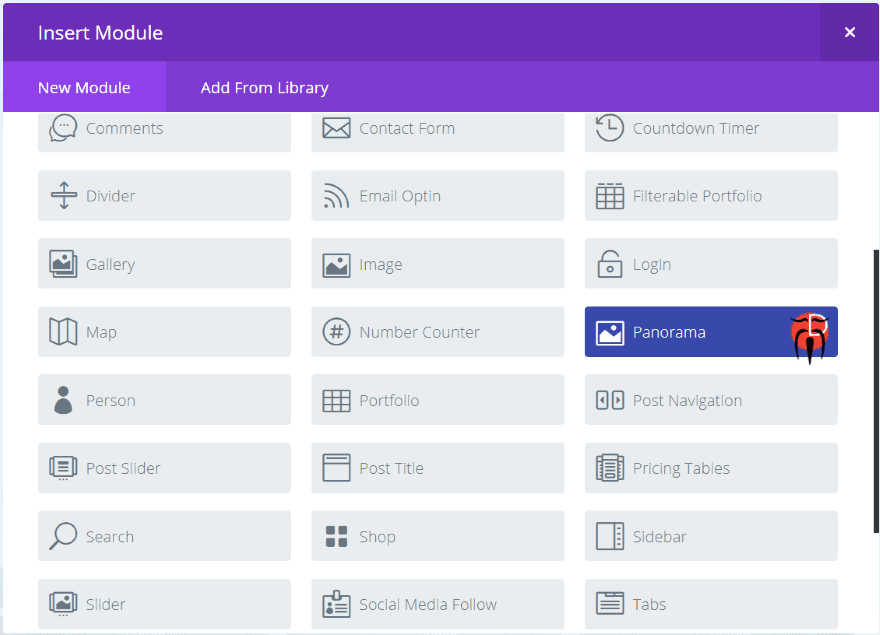
A new module is added to the Divi Builder called Panorama. It’s dark blue and includes the publisher’s logo, so it stands out nicely.
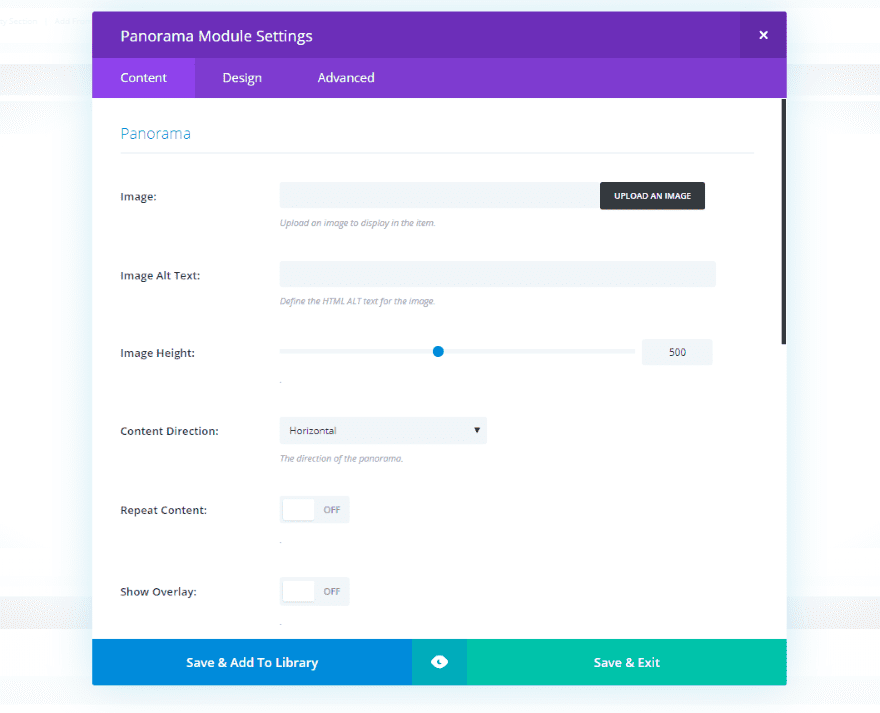
The Content tab includes settings to choose the image, alt text, height, the direction the content can scroll (choose from horizontal or vertical), whether or not the image repeats, to show an overlay, the animation time (the amount of time the image continues to move after you’ve stopped scrolling), type of easing (works with the animation), and background.
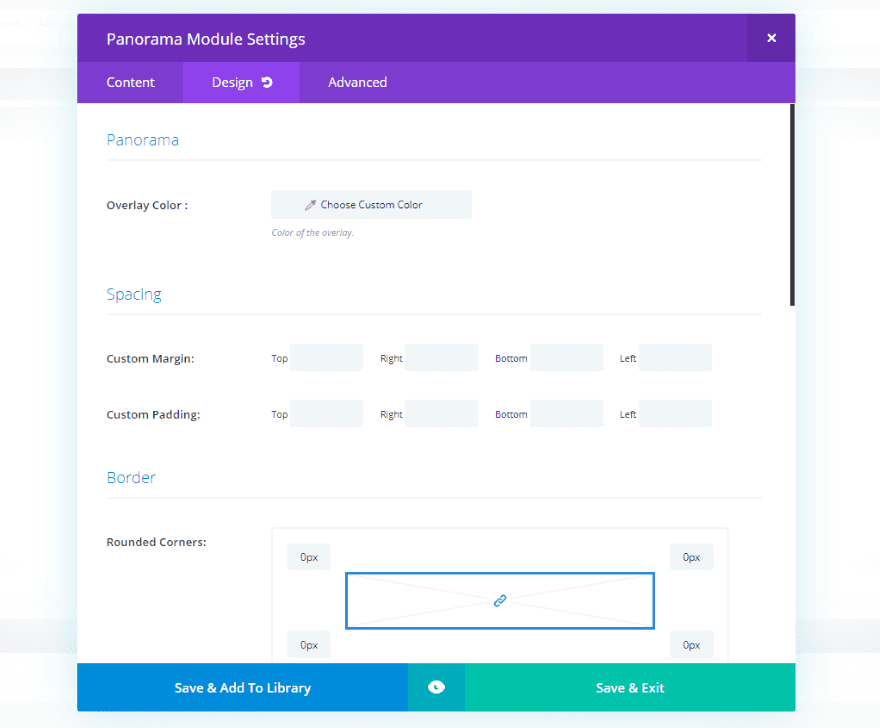
The Design tab includes the overlay color, spacing, border, box shadow, and animation. The Advanced tab includes the standard CSS fields. I like that you can choose the overlay color. I’d like to see a setting for the icon color.
Panorama for Divi Examples
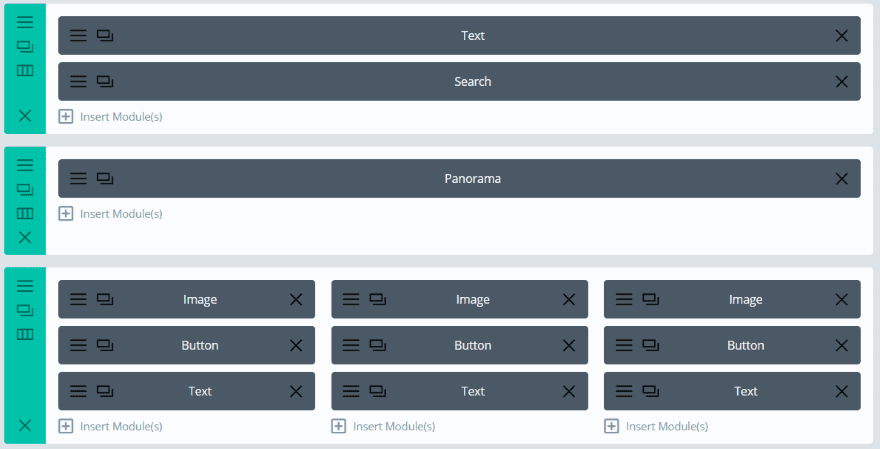
Here’s an example using the default settings for the background and features. I’ve place the module within the Real Estate layout pack using a single-column row. I’ve set the height to match the image (870 pixels) and left the content direction to horizontal.

It’s set to not repeat, so it stops when it gets to the end of the image.

This one does repeat, creating an endless scroll. This is especially good for 360 degree images.
It doesn’t identify itself as scrollable by default. The mouse cursor does change from a pointer to arrows that point in all four directions, but the only way to know that is to hover over it. The cursor pointing in all directions would indicated scrolling in all directions, but it only scrolls horizontally or vertically- not both. This can be solved by adding an overlay.

I’ve added a brown overlay. The overlay itself adds an icon with a hand showing that the image can be scrolled. It uses an arrow to show it can be scrolled horizontally. The opacity level is set to 20% by default. I left it at the default setting.

The overlay and icon go away on hover and your cursor becomes the 4-way arrow.
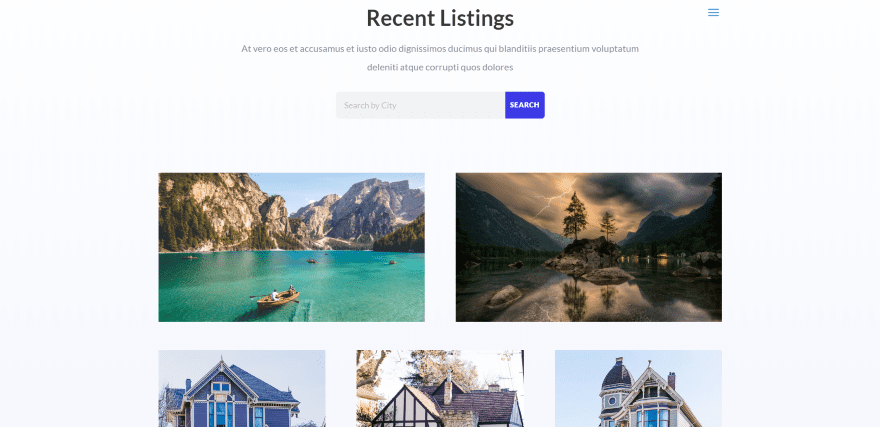
Here’s an example of when the overlay is helpful. For this one I wanted to place it next to an image in a two-column row. I’ve set the height to 287 pixels to match the image’s height. The problem is they both look like normal images, so I’ll need to add an overlay.
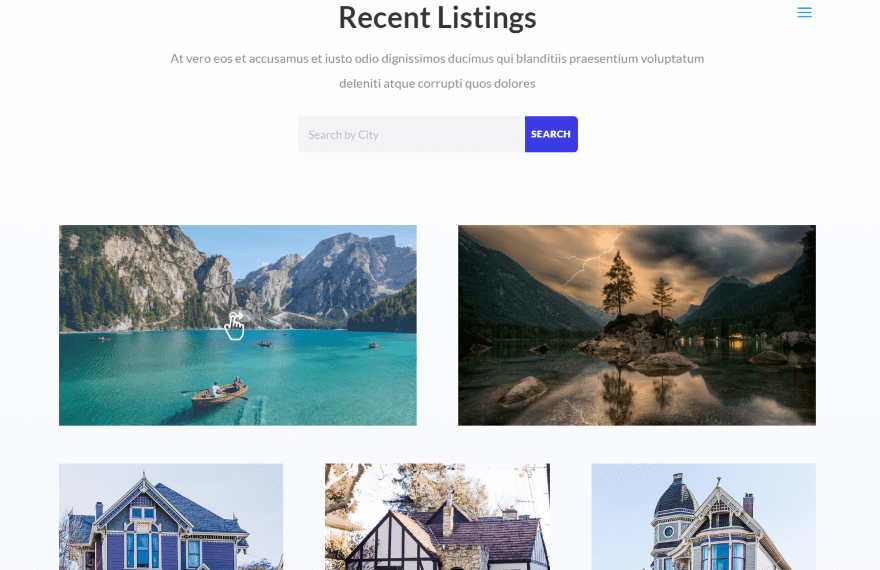
I’ve added a blue overlay. The icon stands out and you can tell that this one is scrollable when the others are not.
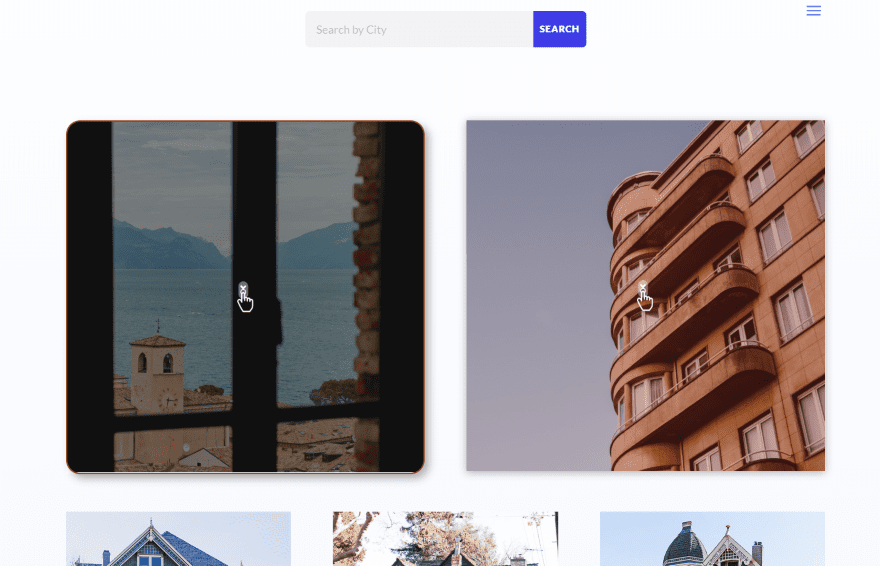
These examples both use vertical content direction. I’ve set the height to 500 pixels and added overlays. The one of the left has a black overlay with a transparency of 40% and a rounded border with box shadow. The one on the left has a red overlay with the default transparency and has box shadow.

This one uses animation and easing. The animation is set to 1000 (1 second) and the easing is Ease In.
The easing determines how the scroll works.
- Linear scrolls as you scroll and then continues the scroll until the animation time is over. It’s the smoothest scroll.
- Ease In Out waits until you’ve moved your mouse to scroll and then continues the scroll until the animation time is over.
- Ease Out scrolls instantly and continues until the animation time is completed. It works similarly to Linear.
- Ease In waits until your mouse is done and then continues the scroll until the animation time is complete.
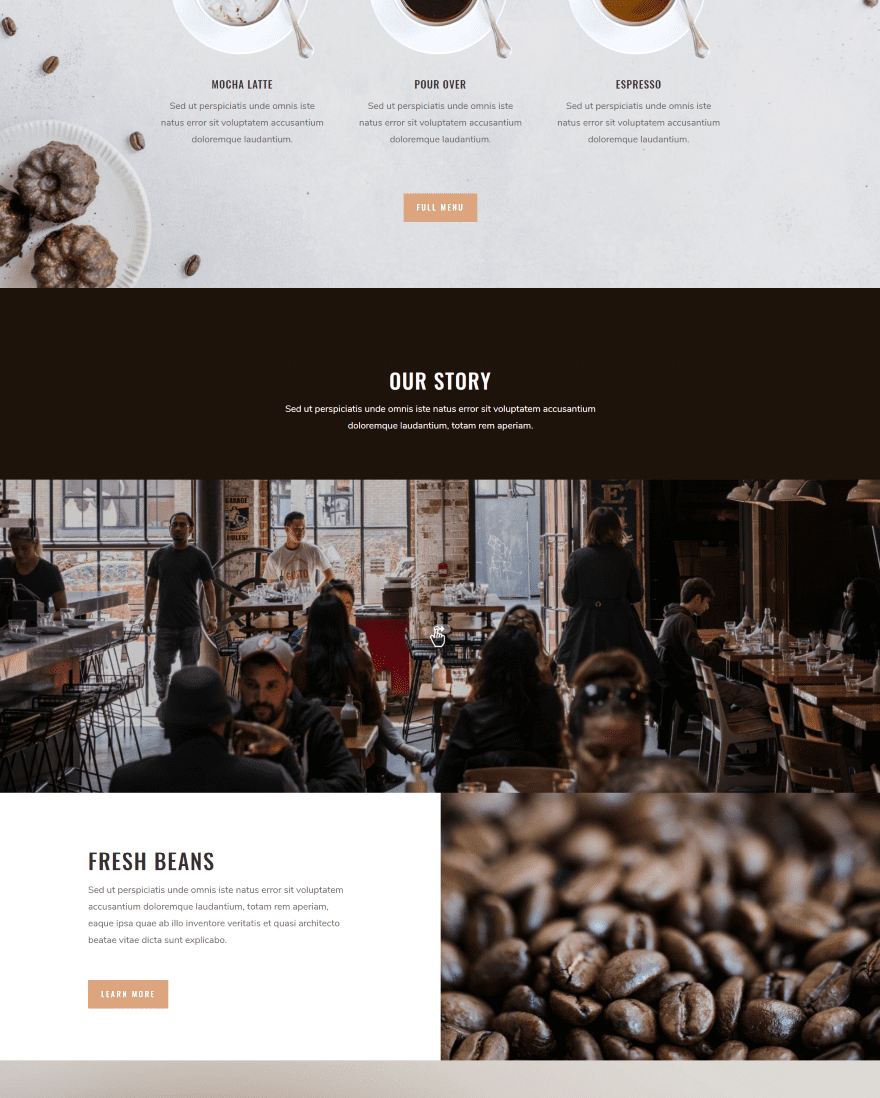
Here’s another example of how it looks within a layout. In this example I’ve placed a horizontal panorama within the Coffee Shop layout pack, replacing the video module to show a 360 degree photo of the coffee shop. It uses a black overlay with 20% transparency. It looks great as it is, but I think this would look even better with a larger icon.
Using Panorama for Divi with the Visual Builder
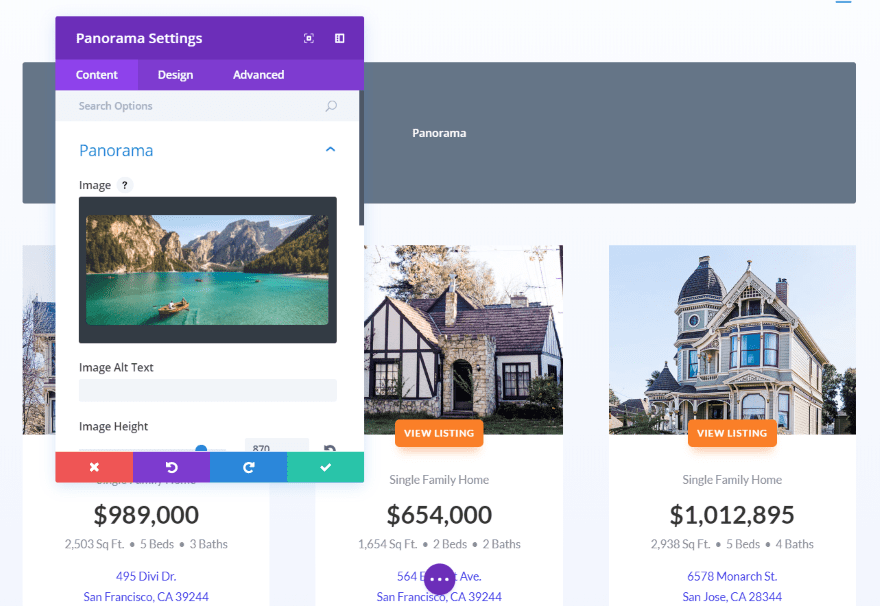
It doesn’t display the panoramic image in the Visual Builder, but you can make all of the adjustments. You just won’t see the effects while in the Visual Builder.
Using Panorama for Divi with Extra

It worked well with Extra. There were no differences regardless of whether I used Divi or Extra, so I didn’t have to change any of the formatting.

Here’s the coffee shop example using a sidebar. The image isn’t as wide of course, but this doesn’t matter as much when you can scroll the panorama. This is one of the advantages of the panorama. A regular image would have reduced in size, which is fine for many images, but when you want to show the larger image this is a great choice.
License
There are two licenses to choose from:
- Single site – $7.99
- Unlimited sites – $21.99
You can see the purchase information at the developer’s website.
Ending Thoughts
Panorama for Divi is an interesting plugin. I like the idea of displaying large images in a small space. My favorite use for Panorama for Divi is for 360 degree photos. This can be a location, a home to display the rooms, events, etc.
It works great as it is, but I can see a few ways where it can be expanded. For example, I’d like to see an option to choose different icons and an option to style them in both color and size.
I found the plugin easy to use. Most of the settings are either labeled or self-explanatory. If you’re interested in adding panoramas to your Divi layouts, Panorama for Divi is worth a look.
We want to hear from you. Have you tried Panorama for Divi? Let us know what you think about it in the comments.
Featured Image via Natykach Nataliia / shutterstock.com
The post Divi Plugin Highlight: Panorama for Divi appeared first on Elegant Themes Blog.
Food, Health and Environmental Future Day: Biotechnology Drives Sustainability

On Tuesday, June 5, 2018, BIO hosted its Food, Health and Environmental Future Day at the 2018 BIO International Convention.
Kicking off the half-day of panel discussions was USDA’s Under Secretary for Marketing and Regulatory Programs Greg Ibach, who discussed, among other topics, his agency’s focus to “put together a regulatory framework for today and tomorrow.”

Greg Ibach, USDA Under Secretary for Marketing and Regulatory Programs
Under Secretary Ibach provided candid insights into USDA’s rulemaking process for the National Bioengineered Food Disclosure Standard and asked industry to “engage and embrace” in the rulemaking process (due to end on July 3, 2018) to ensure a regulatory system that works across the food and agriculture industry, from small startups to large corporations.

Trace Sheehan, writer and producer, Food Evolution
Ibach’s remarks were followed by a keynote address from Trace Sheehan, writer and producer of the film Food Evolution. Sheehan focused on the need for honest, constructive dialogue on either side of the GMO and food innovation debates to drive public acceptance of new technologies.
Sheehan’s focus on constructive dialogue set the stage perfectly for the panel to follow, which included food companies and retailers discussing how they are managing the wave of innovation taking place in the industry and driving consumer acceptance.
Kevin Diehl, Director of Global Regulatory Seed Platform at Corteva Agriscience, noted many of the innovations being developed in the industry are to solve-real world challenges and drive sustainability, such as disease-resistant plants. All the panelists acknowledged, however, that while solutions to real-world challenges will help in driving consumer acceptance of new food technologies, the gap is significant. Even so, Jason Garbell, Senior Director for New Business and Alliance Development at Novozymes, said that food companies “can’t think about innovation as a turn off.” Tammy Lee, CEO and President of Recombinetics, added “science is the key to solving sustainability challenges.”
Following the two-part dialogue, the program shifted focus to the food and agriculture innovation taking place in the convention’s backyard: the New England region. Vermont’s Secretary of Agriculture Anson Tebbetts provided opening remarks before four panelists from the region spoke about their use of biotechnology.

Joanna Lidback, Dairy Farmer, Farm at Wheeler Mountain
Joanna Lidback, a dairy farmer from Vermont, spoke passionately about the role biotechnology has on her family farm, allowing her to produce products more efficiently and sustain her business. Lidback noted that biotechnology is not just for large food companies and that the innovations in food and agriculture allow family farms like hers to thrive.
Following the “Biotech in our Backyard” panel, the program shifted back to a national perspective with investment experts sharing their insights on the funding ecosystem in agricultural technology.
In the discussion, Roger Wyse with Spruce Capital Partners underscored Kevin Diehl’s point in the food innovation dialogue, noting many agtech investors are looking to fund companies that address major challenges.
Finally, to close Food, Health and Environmental Future Day, Jerry Flint, Vice President, Global Initiatives and Sustainability at Corteva Agriscience, hosted a fireside chat alongside Governor Dennis Daugaard of South Dakota and Governor Ricardo Rossello of Puerto Rico. Both governors spoke about their region’s investment in biotechnology and the promise it brings to the future of their economies.
“If you’re not paying attention to agriculture, you’re not paying attention to the economy,” said Governor Daugaard.

Right to Left: Governor Dennis Daugaard, South Dakota; Governor Ricardo Rossello, Puerto Rico; Jerry Flint, Corteva Agriscience
Governor Rossello added that while Puerto Rico is still recovering from Hurricane Maria, his region sees opportunity to further expand the economy through biotechnology. Governor Rossello noted that for every dollar his government invests in biotechnology, $5.36 comes back to the economy, representing a significant return on investment.
BIO’s 2018 Food, Health and Environmental Future Day included:
- Greg Ibach, Under Secretary for Marketing and Regulatory Programs, USDA
- Phil Miller, Vice President for Global and Regulatory and Government Affairs, Monsanto
- Trace Sheehan, Writer and Producer, Food Evolution
- Natalie DiNicola, President, DiNicola LLC (moderator)
- Tammy Lee, President and CEO, Recombinetics
- Kevin Diehl, Director, Global Regulatory Seed Platform, Corteva Agriscience
- Jason Garbell, Senior Director, New Business and Alliance Management, Novozymes
- Jane Andrews, Corporate Nutrition Manager, Wegmans
- Tony Freytag, Executive Vice President, Crunch Pak
- Doug Cole, Senior Manager of Marketing and Biotech Affairs, Simplot Plant Sciences
- Ron Stotish, President and CEO, AquaBounty Technologies (moderator)
- Al Kriz, Strategic Alliance Manager Trait Research & Genomics, Bayer LifeHub
- Victor Guzov, Lead, Protein Optimization and Evolution Team (POET), Monsanto
- Mark Cooper, Plant Manager, Scotts Miracle-Gro
- Joanna Lidback, Vermont dairy farmer, The Farm at Wheeler Mountain
- Aaron Schacht, Vice President, Research and Development, Elanco Animal Health
- Colin Steen, Managing Director, Syngenta Ventures
- Roger Wyse, Spruce Capital Partners
- Jerry Flint, Vice President, Global Initiatives and Sustainability, Corteva Agriscience (moderator)
- Governor Dennis Daugaard, South Dakota
- Governor Ricardo Rossello, Puerto Rico
Global Pharmaceutical & Biotechnology Environmental Monitoring Market 2018 with Geographic …
The Global Pharmaceutical & Biotechnology Environmental Monitoring Market will accomplish xxx Million USD in 2018 and CAGR xx% 2018-2023.
Robin Roberts Shares the Journey

When Good Morning America co-anchor Robin Roberts was diagnosed with cancer in 2007, she took her mother’s advice to “make your mess your message,” and connect with her audience as she was treated for and recovered from her disease. For those without the resources and platform that she had, “I needed to be their voice and show them the journey,” Roberts recalled during the Tuesday morning keynote session at the Biotechnology Innovation Organization’s international convention.
Roberts, an award-winning broadcast journalist and author, and a survivor of breast cancer and myelodysplastic syndrome (MDS), was interviewed in a wide-ranging discussion by BIO president and CEO James Greenwood.
Roberts repeatedly credited her family and her faith for her personal and professional successes. Her father was a Tuskegee Airman – one of the storied group of World War II African-American fighter pilots – and her mother was appointed to the Mississippi state board of education, later becoming its chairwoman. The family focus on education was “less about the ‘three Rs,’” she quipped, and more about the three Ds – “discipline, determination, and d’Lord.”
Roberts also colorfully described her early career – it included a stint as a country music DJ on AM radio and a gig as a weekend sports anchor paying $5.50 per hour – and later highlights including interviewing President Barack Obama on the subject of marriage equality, and her emotional coverage of the aftermath of Hurricane Katrina, during which she set out for the Gulf Coast when the storm’s great damage became evident. “I couldn’t go on the air until I found my family,” she said (and when she did, her mother ordered her back to her television crew).
A personal thank you from #BIO2018 keynote speaker @robinroberts to the #biotech community pic.twitter.com/lpsPxdmxTM
– BIO Intl Convention (@BIOConvention) June 5, 2018
Living proof
Before his conversation with Roberts, Greenwood told the story of Ashanthi De Silva, who was born in 1986 with two broken copies of a gene that makes a protein called ADA. This meant she had severe combined immune deficiency, and “by age four, she was slipping away,” he said. But De Silva’s doctor knew of a team of scientists at the National Institutes of Health who were pioneers in applying genetic engineering to human health. She became first patient in the world to receive a gene therapy. Twenty-eight years later Ashanthi remains on enzyme replacement therapy but leads a full and normal life. “This is the power of biotechnology” says Greenwood.
As he advocated for strong policies to support the continued development of the biotechnology industry Greenwood dotted the line from De Silva’s treatment through to more recent breakthroughs, including the approval in 2017 of the first gene therapies in the US – Novartis’ cell therapy for a kind of pediatric leukemia, Kymriah, Gilead Sciences’ cell therapy for aggressive lymphoma, and Spark Therapeutics gene therapy for inherited retinal diseases, which can prevent children with a particular genetic mutation from going blind.
Taking the stage, De Silva received the morning’s loudest ovation as a living embodiment of biotech innovation. She urged patients and patients’ families to “look at my story and see anything is possible.” With patients now at the forefront, telling their own stories, she said, “please have hope, be your own advocate, and please, never give up.”
BioGENEiuses
They keynote also featured the 2018 International BioGENEius Challenge finalists. “Some day you’re going to be working for these kids,” joked Greenwood. One of those high schoolers was awarded the grand prize. Ontario, Canada eleventh grader Sajeev Kohli’s project “recruiting endogenous proteins for site-specific transport: a novel workflow for gene carrier design” earned him the $7,500 award, as judged by a panel of industry and academic experts.
Not long after Robinson began sitting on the HeLa genome board, another board member asked …
“This will be your intro into biotechnology,” says Dr. Timothy Fawcett, the Science director at BTI as he lectures Robinson and her classmates, …
Director of USPTO Addressed Intellectual Property Track Opening Plenary


(left to right) Associate Counsel and Director, Intellectual Property Policy Melissa Brand, USPTO Director Andrei Iancu, Deputy General Counsel and Vice President Hans Sauer
This afternoon USPTO Director Andrei Iancu delivered remarks at the BIO International Convention’s Intellectual Property Track opening plenary. During the well-attended session, Director Iancu addressed a key policy priority for BIO – reform within the Patent Trial and Appeal Board (PTAB).
Last month, the USPTO signaled an intention to replace the broadest reasonable interpretation (BRI) standard for construing unexpired patents with the same standard used in Federal district courts and the International Trade Commission – a turn of events BIO views favorably.
According to Iancu, he is looking for more efficiency within this system. It remains to be seen what that will look like, however a positive outcome will certainly mean an overall reduction of IPR claims.
Director Iancu also went on to address his concerns relating to lack of clarity when it comes to patent eligible subject matter under 35 U.S.C. 101.
BIO has long shared these concerns and looks forward to opportunities to contribute to constructive reform efforts. Clarification of patentability criteria and improvements of the PTAB will enhance American biotech innovators ability to compete on a level playing field.
Success – You’ve Entered the Contest! – Today’s Homeowner
Thank you for entering the Curb Appeal Makeover Contest sponsored by Therma-Tru Doors and Today’s Homeowner Media! We have received your entry. Ready to start designing your dream entry door? With Therma-Tru Doors’ Design Your Door tool, it’s easy to create the perfect entryway and see how it will look on your home! Click here […]
Addressing Food Innovation Across the Value Chain at Convention

In a matter of days countless biotechnology companies will descend on Boston for the 2018 BIO International Convention. We’ve highlighted some of the programming you can look forward to at “Food, Health and Environmental Future Day” on Tuesday, June 5, including the “Biotech In Our Backyard” panel and the keynote address, featuring Trace Sheehan, writer and producer of the film Food Evolution.
At Food, Health and Environmental Future Day, BIO will also be hosting a two-part panel discussion looking at new food innovation tools and how retailers and food companies are managing the wave of innovation taking place in the industry.
“Cutting -Edge Food, Health, & Environmental Products and Tools… Coming to a Grocery Store Near You(?)” will take place from 1 – 2:45 pm, following the keynote address by Trace Sheehan. The discussion will be moderated by Natalie DiNicola, President of DiNicola LLC. Here’s a rundown what to expect and who you’ll hear from in the two-part discussion:
Part I: The Landscape of Innovation Now and On the Horizon
A range of cutting-edge new tools are providing researchers, companies, and investors with new prospects for solving diverse challenges. Part One of the Food Innovation Dialogue looks at the landscape of innovation now and on the horizon, including applications of gene editing in animals and plants, microbes for soil health, and more…
- Tammy Lee, President and CEO, Recombinetics
- Kevin Diehl, Director, Global Regulatory Seed Platform, Corteva Agriscience
- Jason Garbell, Senior Director, New Business and Alliance Management, Novozymes
Part II: Addressing Food Innovation Across the Entire Value Chain
In Part One, you’ll hear about the new tools that will change the reality of food production and animal health, but we also know that pressures in the grocery and retail sector reverberate up and down the value chain. What do food manufacturers and retailers need? How do consumer preferences impact food companies’ sustainability goals? Part Two of the Food Innovation Dialogue brings the value chain together as we work to answer these and other critical questions that will shape the innovations to come.
- Jane Andrews, Corporate Nutrition Manager, Wegmans
- Tony Freytag, Executive Vice President, Crunch Pak
- Doug Cole, Senior Manager of Marketing and Biotech Affairs, Simplot Plant Sciences
Here’s a full rundown of all the programming at Food, Health and Environmental Future Day:
Noon – 12:15 pm || Food, Health and Environmental Future Day Opening Remarks by Greg Ibach, USDA Under Secretary for Marketing and Regulatory Programs
12:15 – 12:45 pm || Food Innovation Keynote by Trace Sheehan, writer and producer of Food Evolution
1 – 2:45 pm || Two-Part Food Innovation Dialogue: Cutting-Edge Food, Health, & Environmental Products and Tools… Coming to a Grocery Store Near You(?)
3 – 4 pm || Biotech in our Backyard: New England’s Booming Food and AgTech Innovation Ecosystem
4 – 5 pm || AgTech Investment: Opportunities for Plants, Animals, Microbes, and Beyond…
5 – 5:30 pm || Governor’s Fireside Chat with South Dakota Governor Dennis Daugaard: Growing the Bioeconomy across the U.S.
5:30 – 6 pm || Food, Health, and Environmental Future Day Reception
Be sure to check out the Food and Agriculture blog throughout the convention for highlights from Food, Health and Environmental Future Day, as well as highlights from the entire 2018 BIO International Convention. And for those attending, see you in Boston!
